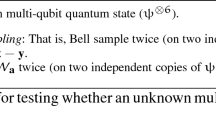Abstract
This paper describes a pseudorandom pattern generator for the random pattern test of combinational circuits. Suppose that a fractionp of the possible patterns detects some fault and the generator generates L patterns to test the circuit. Then the probability that the generator generates a pattern that tests the fault is at leastpL/(pL + 1). The only assumption is that all values of the seed of the generator are equally likely. The seed is twice as long as a single pattern. The generator is less than twice as expensive as a linear feedback shift register. Thus, it can be used in practice. More complicated generators that achieve a better bound are also discussed.
Similar content being viewed by others
References
P. H. Bardell and W. H. McAnney. Self-Testing of Multichip Logic Modules,Proceedings of the 1982 International Test Conference, 1982, pp. 200–204.
Z. Barzilai, V. S. Iyengar, B. K. Rosen, and G. M. Silberman. Fault Modeling and Simulation of SCVS Circuits,Proceedings of the IEEE International Conference on Computer Design: VLSI in Computers, 1984, pp. 42–47.
L. Blum, M. Blum, and M. Shub. A Simple Secure Pseudo-Random Number Generator,Advances in Cryptology: Proceedings of CRYPTO 82 (edited by D. Chaum, R. L. Rivest, and A. T. Sherman), Plenum, New York, 1983, pp. 61–78.
M. Blum and S. Micali. How To Generate Cryptographically Strong Sequences of Pseudo Random Bits,Proceedings of the 23rd IEEE Symposium on Foundations of Computer Science, 1982, pp. 112–117.
J. L. Carter. The Theory of Signature Testing for VLSI,Proceedings of the ACM Symposium on Theory of Computing, 1982, pp. 66–76.
J. L. Carter and M. L. Wegman. Universal Classes of Hash Functions,J. Comput. System Sci.,18 (April 1979), 143–154.
B. Chor and O. Goldreich. On the Power of Two-Point Based Sampling,J. Complexity,5 (1989), 96–106.
E. B. Eichelberger, and T. W. Williams. A Logic Design Structure for LSI Testability,Proceedings of the 14th Design Automation Conference, 1977, pp. 462–468.
J. Galambos. Methods for Proving Bonferroni Type Inequalities,J. London Math. Soc. (2),9 (1975), 561–564.
J. Galambos. Bonferroni Inequalities,Ann. Probab.,5 (1977), 577–581.
M. Y. Hsiao. Generating PN Sequences in Parallel,Proceedings of the Third Annual Princeton Conference on Information Sciences and Systems, 1969.
D. E. Knuth.The Art of Computer Programming, Vol. 1, Addison-Wesley, Reading, MA, 1973.
D. E. Knuth.The Art of Computer Programming, Vol. 2, Addison-Wesley, Reading, MA, 1980.
B. Konemann, J. Muncha, and G. Zwiehoff. Built-in Logic Block Observation Techniques,Proceedings of the 1979 Test Conference, 1979, pp. 37–41.
M. Luby. A Simple Parallel Algorithm for the Maximal Independent Set Problem,Proceedings of the 17th ACM Symposium on Theory of Computing, 1985, pp. 1–10.
W. W. Peterson and E. Weldon, Jr.Error Correcting Codes, MIT Press, Cambridge, MA, 1972.
J. Savir, G. Ditlow, and P. Bardell: Random Pattern Testability,Proceedings of the 13th International Symposium on Fault Tolerant Computing, 1983, pp. 80–89.
A. Shamir. On the Generation of Cryptographically Strong Pseudo-Random Sequences,ACM Trans. Comput. Systems,1 (1983), 38–44.
T. Spencer. Good Pattern Generators for Random Pattern Test, Technical Report, 88-3, Rensselaer Polytechnic Institute, Troy, NY, 1986.
T. Spencer. Generalized Bonferroni Inequalities,J. Appl. Probab. (to appear).
S. Tezuka. On the Discrepancy of GFSR Pseudorandom Numbers,J. Assoc. Comput. Mech.,37 (1987), 939–949.
A. C. Yao. Theory and Applications of Trapdoor Functions,Proceedings of the 23rd IEEE Symposium on Foundations of Computer Science, 1982, pp. 80–91.
Author information
Authors and Affiliations
Additional information
Communicated by F. Thomson Leighton.
This research was supported in part by the National Science Foundation under Grants CCR-8810609 and CDA-8805910.
Rights and permissions
About this article
Cite this article
Spencer, T.H. Provably good pattern generators for a random pattern test. Algorithmica 11, 429–442 (1994). https://doi.org/10.1007/BF01293265
Received:
Revised:
Issue Date:
DOI: https://doi.org/10.1007/BF01293265




